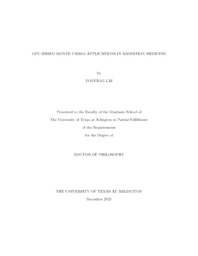
ATTENTION: The works hosted here are being migrated to a new repository that will consolidate resources, improve discoverability, and better show UTA's research impact on the global community. We will update authors as the migration progresses. Please see MavMatrix for more information.
Show simple item record
| dc.contributor.advisor | Chi, Yujie | |
| dc.contributor.advisor | Jia, Xun | |
| dc.creator | Lai, Youfang | |
| dc.date.accessioned | 2023-06-28T14:46:50Z | |
| dc.date.available | 2023-06-28T14:46:50Z | |
| dc.date.created | 2021-12 | |
| dc.date.issued | 2021-12-02 | |
| dc.date.submitted | December 2021 | |
| dc.identifier.uri | http://hdl.handle.net/10106/31364 | |
| dc.description.abstract | Radiation can be used to image tumor site or kill tumor cells noninvasively, playing an important role in tumor diagnosis and treatment. Because of the increasing burden that cancer brings to the society, there always exists the demand of improving imaging resolution and contrast and improving radiation conformity for therapy. This depends on not only the advances of techniques, but, probably more importantly, the accurate and efficient modelling of radiation transport, enabling research on proof-of-concept for new tech and more complicated physics and chemical process in a quantitative way. Monte Carlo (MC) simulation method has been extensively used in medical physics to model particle transport and calculate corresponding desired information such as dose deposition, because it can describe the physics and chemical process in a faithful way and handle different geometry configuration flexibly. Recent years have witnessed the success of MC method in guiding design of new detectors, scattering correction, dose calculation and simulation of DNA damage to better understand radiation induced damage etc.. Yet, MC simulation still suffers from low computational efficiency, which restrict the problem size or complexity for research and shows difficulty in meeting clinical on-site requirements.
Graphical Processing Unit (GPU) provides a solution to this issue, because it can accelerate program by parallelism. However, the adaption of MC code into GPU compatible version is not trivial, considering the possible slowdown or even mistakes due to improper handle of race condition and thread divergence in parallel programming. It is of great importance to develop stable GPU-based codes and validate them. The developed codes should hide details like memory operation to users but allow flexible input, thus being beneficial to both research and clinical communities. This thesis targets on this purpose and has conducted a lot of code development and application tests. Specifically, We developed gPET for simulation of positron emission tomography (PET) and studied performances of designs of PET scanner. We also developed source models for MRI-LINAC based on gDPM, a code for MeV photon and electron transport. We pointed out again the defects in determining dose for biological experiments by gCTD, a code for keV photon transport. The simulated results deviated from hand-calculated results by look-up table or the assumption that dose is uniform.
In addition, We did a lot of studies in microscopic simulation, along with the development of gMicroMC. We gradually added support for electron transport, heavy ion transport, presence of DNA in chemical stage and presence of oxygen in chemical stage. We used it to study the parameter sensitivities, showing that the cross section and the damage model for DNA strand break are still the biggest issues. We studied the dose inhomogeneity in proton irradiation scenario. DNA damage was shown to vary in different cells and its relationship to cell survival fraction was updated as well. We also studied radio-protective effect of hypothermia, where diffusion and chemical reaction rates were thought be altered by temperature change. The curves of normal tissue complexity probability (NTCP) and number of DNA doubles strand breaks (DSBs) coincided for different temperature. Our results showed that less initial DNA damage at low temperature was the reason for radio-protective effect of hypothermia.
Further, we studied the radical yield with different oxygen concentrations. We concluded that oxygen was not likely to be depleted purely by water radiolysis no matter how large the dose rate was for given dose 30 Gy. We also built a model for oxygen enhancement on DNA damages. This model was applied to high dose rate condition again to study the effect of pulse width, pulse interval, dose in the pulse on the DNA damage yields. It was shown that only when pulse was short enough that DNA damage yield had a decent reduction. Our results might provide an explanation for FLASH therapy sparing normal tissues. | |
| dc.format.mimetype | application/pdf | |
| dc.language.iso | en_US | |
| dc.subject | GPU, Monte Carlo, Radiotherapy, FLASH, PET | |
| dc.title | GPU-based Monte Carlo Applications in Radiation Medicine | |
| dc.type | Thesis | |
| dc.date.updated | 2023-06-28T14:46:51Z | |
| thesis.degree.department | Physics | |
| thesis.degree.grantor | The University of Texas at Arlington | |
| thesis.degree.level | Doctoral | |
| thesis.degree.name | Doctor of Philosophy in Physics and Applied Physics | |
| dc.type.material | text | |
Files in this item
- Name:
- LAI-DISSERTATION-2021.pdf
- Size:
- 50.52Mb
- Format:
- PDF
This item appears in the following Collection(s)
Show simple item record


